Are you an outdoor enthusiast looking for a reliable and sustainable source of light during your adventures? Look no further than a solar flashlight! These innovative and eco-friendly devices harness the sun’s power to provide you with a bright and long-lasting light source.
With so many options on the market, it can be overwhelming to choose the right one. That’s why we’ve compiled a list of the 10 best solar flashlights for outdoor adventures, so you can make an informed decision and be prepared for any situation. Read on to discover the top solar flashlights that will enhance your outdoor experience.
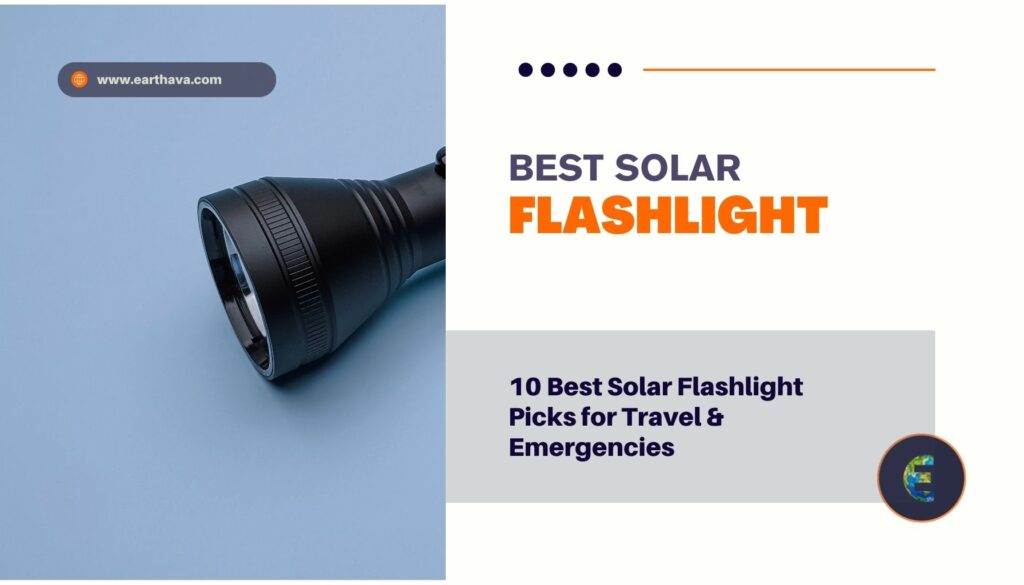
Top 3 Picks
🥇DaringSnail Emergency Weather Radio
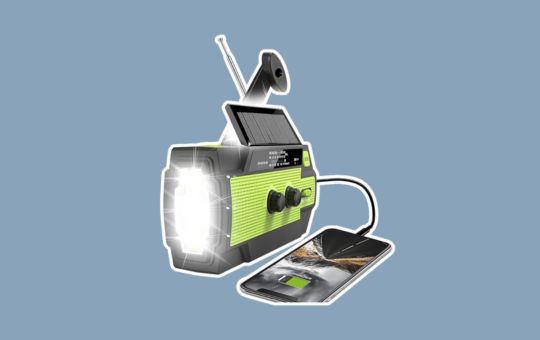
Summary
Honest, reliable, and surprisingly capable, this radio punches above its price class. Whether you’re prepping for storms or building a go-bag, the DaringSnail MD-090P delivers strong reception, multipronged charging, and real-world practicality. The solar and crank options make it resilient during outages, while reviews and testers call it one of the best emergency radios value-wise on the market.
🥈E-SHIDAI Solar/Rechargeable LED Flashlight
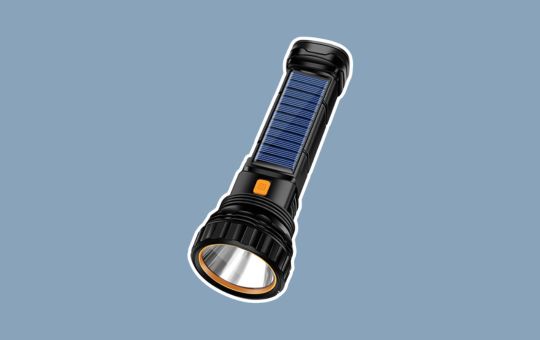
Summary
This model shines—literally—with its high brightness, multi-functionality, and handy backup charging. Great in a pinch for outdoor activities, power outages, or as a pocket survival tool. Just temper your expectations for the solar charging: it’s a helpful backup, but don’t depend on it to fully recharge the unit in a rush.
🥉Otdair Solar/Rechargeable LED Flashlight
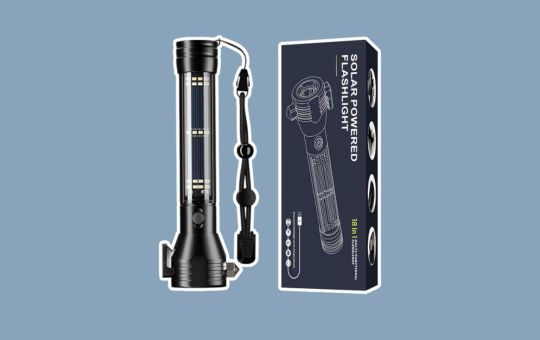
Summary
This flashlight packs features into a rugged package: solid brightness, emergency modes, alarm, and dual charging options. Solar power works, but slowly. Think of it as an extra, not your main charging method. Real-life reviews are mixed: some praise the sturdy build and convenience, while others report durability issues and charging failures.
Top 10 Best Solar Flashlights
1. Otdair: LED Emergency Solar Flashlight

The Otdair Solar/Rechargeable LED Flashlight pops up on a lot of “must-have” lists. It isn’t a decoration in itself; it’s more of a tool. But we decided to include it because many buyers use it for outdoor setups, late-night adjustments, or even walking around safely once the lights are up. It’s positioned as a multi-function survival flashlight: solar charging option, USB-C recharge, five different light modes, and even an emergency strobe. On paper, it sounds like the sort of thing you’d toss into a Halloween box one year and keep using on camping trips or power outages.
Specs-wise, here’s what it offers: an ultra-bright LED (manufacturers often throw “ultra-bright” around loosely, but real-world tests put it at about a few hundred lumens, not the thousands sometimes implied), 5 lighting modes (high, medium, low, strobe, SOS), built-in solar panel for trickle charging, a rechargeable battery that can also be powered by USB-C, and a rugged, waterproof-ish casing. Some sellers call it “survival gear,” which is… partly true. It’s handy, yes. However, as reviewers often point out, the solar charging feature is more of a backup; it takes hours in direct sunlight to give even a modest top-up. If you’re expecting a fully solar-powered flashlight for nightly use, that’s not realistic.
The standout feature here, based on reviews, is its versatility. People like that it’s not just a flashlight: the strobe/SOS functions add an extra layer of usefulness if you’re in a rural area or even just want a flashing light on hand while walking kids. The drawback? Battery life under continuous high beam use isn’t impressive. Some users said it dims faster than expected, and if you rely on solar alone, you’ll be disappointed.
Who is this for? According to feedback, it’s best suited for homeowners or outdoor hobbyists who want a backup flashlight that can handle both dark nights, “not the movie tho” (for setting up lights, walking paths, or last-minute repairs), and general emergencies. It’s less suited for anyone expecting long-term off-grid performance; think of it as a reliable hybrid, not a powerhouse survival torch.
A few quick notes from our research
- Beam distance is decent for household and yard tasks, but doesn’t compare to professional outdoor spotlights.
- Durability is good, though not military-grade. Drop it, and it’ll likely be fine; drive over it, maybe not.
- The USB-C recharge is fast and reliable, which most people end up using 90% of the time.
- The solar panel feels more symbolic than practical, again, good for topping off, not full daily reliance.
✅ Pros
- Dual charging (USB-C + solar backup)
- Multiple modes, including emergency SOS/strobe
- Portable, versatile, and works for Halloween nights and camping alike
- Decent build quality for the price
⚠️Cons
- Solar charging is slow and impractical for full use
- The battery drains quickly on high beam
- Brightness is often overstated in listings
Earthava’s Take: The Otdair flashlight isn’t a “game-changer,” but it is a practical little multi-tool that earns its spot when you need light without fuss. It’s more the helper behind the scenes than the star of the show, something to keep in your pocket while adjusting decorations or walking around your yard. Just go in knowing the solar panel is there as a backup trickle charger, not a full power source, and you’ll be satisfied.
Specs And Key Features
| Price: | $19.99 |
| Battery: | NiMH |
| Material: | Metal. |
| Color: | Black. |
| Light Color: | White. |
| Weight: | 1.06 Pounds. |
| Bulb Type: | LED. |
| Lumens: | 500. |
| Waterproof: | IPX5. |
| Key Features: | Multipurpose. |
2. NPET: LED Car Flashlight
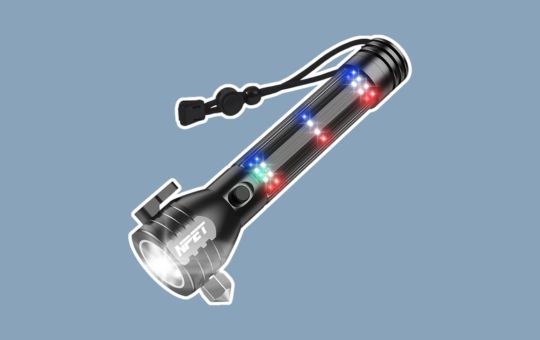
The NPET T10 isn’t just marketed as a flashlight. It’s more like a Swiss army knife squeezed into a handheld torch, promising to be your “get-out-of-trouble” kit when things go sideways. Based on the specs, it’s not only a 500-lumen LED with a COB side light, but also a seatbelt cutter, window breaker, compass, power bank, siren (a loud 120dB, if claims hold up), and a solar-rechargeable tool for the glove compartment. In other words, it tries to be the flashlight that does everything.
Let’s break down what that looks like in practice
The light itself has two modes: the front LED, which reviewers describe as reasonably bright, though nowhere near the piercing beam you’d expect if you’ve used a professional-grade tactical flashlight. Think enough to navigate in the dark or change a tire at night, not something you’d use to scan a wide forest clearing. Then there’s the COB side light, which works more like a lantern. Handy for camping or roadside repairs, imagine setting it down to light your trunk while swapping a flat tire.
The standout feature, in our research, is the toolset built around safety. The seatbelt cutter and glass breaker aren’t gimmicks; people have tested them and confirmed they actually work. One reviewer even noted it broke tempered glass in a single hit, which is rare for cheap “emergency hammers.” And that siren, while some say it’s more shrill than bone-rattling, could genuinely draw attention if you were stranded on the roadside or felt unsafe.
But here’s where reality undercuts the marketing a bit. The solar charging is more of a backup than a true off-grid solution. Several users point out that it takes days under direct sunlight to get a usable charge, which isn’t practical if you’re actively relying on it. The micro-USB charging port is still the main way you’ll top it up, so the “solar powered” headline feels more like peace of mind than everyday function. Another drawback? The build. Some describe it as solid enough for the price, but not exactly rugged. Drop it hard on pavement, and it might not survive the way a premium tactical torch would.
Who is this flashlight actually for? Based on reviews, it seems best suited to drivers who want a just-in-case tool tucked away in their car. It’s not the brightest, and it’s not the toughest, but the combination of safety features, cutter, breaker, and siren makes it a smart addition to a glovebox. Campers and hikers could use it too, but only if they’re okay with carrying a backup power source for longer trips.
✅ Pros
- Multi-function safety tools (cutter, breaker, siren) that actually work
- Dual light modes for different situations
- Solar panel provides backup charging
- Affordable compared to high-end tactical flashlights
⚠️Cons
- Solar charging is slow, almost impractical for regular use
- Build quality is not as rugged as the “tactical” label suggests
- Brightness is decent, but not truly 500 lumens in real-world use
Earthava’s take: the NPET T10 is less of a flashlight-first and more of a compact safety kit with a light attached. If you frame it that way, expectations line up better. It’s not the toughest torch on the market, but for the price, it’s a thoughtful backup tool that could make a real difference in an emergency.
Specs And Key Features
| Price: | $26.99 |
| Battery: | Lithium Ion. |
| Material: | ABS. |
| Color: | Black. |
| Light Color: | White. |
| Weight: | 1.15 pounds. |
| Lumens: | 500. |
| Waterproof: | Yes. |
| Key Features: | Multipurpose. |
3. E-SHIDAI: 1000 Lumens LED Solar Flashlight

This one looks impressive at first glance, a solar + rechargeable flashlight that claims 1000 lumens, with a built-in strobe, a 1200 mAh battery, and even the ability to act as a tiny power bank. On paper, it’s the sort of all-in-one gadget you’d expect to find in a glovebox or a camping pack.
But digging through reviews, you notice the gap between the numbers and how it feels in the real world. The “1000 lumens” part is probably the most questioned. People say it’s bright, sure, but not in that “flood the woods with daylight” kind of way. More like enough to light a trail in front of you, or a room during a blackout. A lot of buyers mention it feels closer to a mid-range flashlight, not a professional-grade beam.
Solar charging is another detail that needs to be set straight. Yes, it has a solar panel, but it’s small. Realistically, it’s more of a trickle charger; reviewers who left it out in full sun all day said they got some juice back, but not a full recharge. If you’re depending on solar only, it’s going to feel slow. That said, in an emergency, even thirty minutes of usable light could be a lifesaver. So… useful, but not the main charging method.
One thing that does stand out: the emergency strobe. According to users, it flashes strongly enough to catch attention from a car or passerby at night. So, as a roadside tool, it earns its keep. The USB fast charging also gets a thumbs-up; that part works as promised.
The drawback? That 1200 mAh battery. It limits both how long the flashlight can run and how useful the “emergency power bank” really is. You’ll maybe squeeze 10–15% into a smartphone, fine for sending a text or making a call, but not much else. And the runtime isn’t marathon-long either, so don’t expect it to hold up for overnight hiking trips without recharging.
Durability comes up a lot in feedback. Some users report the casing or the switch wearing down after a few months of use. It’s lightweight and portable, which is great, but it doesn’t have the same rugged build as heavy-duty tactical flashlights. So, if you’re tossing it in a backpack for casual camping, fine. If you’re roughing it for weeks off-grid, maybe not.
Who’s it best for? Probably someone who wants a budget-friendly, multifunction backup. The kind of person who keeps an emergency kit in the trunk, or just wants something reliable enough for short blackouts. If you’re expecting a professional survival tool, it’s going to disappoint. If you just need “light when I need it, a little solar boost if I’m stuck,” then it does the job.
✅ Pros
- Lightweight and portable
- USB fast charging works decently
- Solar panel provides emergency top-ups
- Strobe is genuinely useful for roadside safety
⚠️Cons
- Brightness feels lower than the advertised 1000 lumens
- Small 1200 mAh battery limits runtime and power bank function
- Solar charging is slow (more of a backup than a feature)
- Some durability concerns over time
Earthava’s take: The E-SHIDAI flashlight is a “good enough” tool, not the powerhouse the product page suggests, but not useless either. Think of it as a backup you won’t mind forgetting in a drawer until you need it. For occasional use, it’s handy. For hardcore campers or people who want a seriously tough flashlight, it’s going to feel underwhelming.
Specs And Key Features
| Price: | $11.89 |
| Batteries: | 1200 mAh battery. |
| Material: | ABS plastic and Aluminium alloy. |
| Color: | Black. |
| Weight: | 5.4 Ounces. |
| Dimensions: | 6.88 x 2.28 x 2.28 Inches. |
| Lumens: | 1000. |
| Waterproof: | IPX4. |
| Key Features: | MultiPurpose. |
4. Serjur: Multi-Function Solar-Powered Flashlight
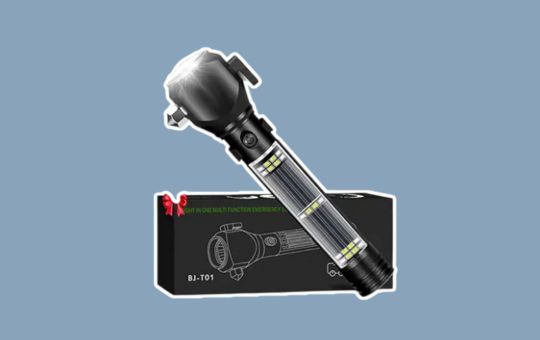
The Serjur flashlight tries to be more than just a flashlight. And honestly, that’s what it’s known for, a “Swiss army knife” approach packed into one handheld device. Alongside the LED beam, you get a glass breaker, a seatbelt cutter, an alarm, solar and USB charging, plus a small power bank function for topping up a phone. On paper, it looks like something you’d toss in the glove compartment and forget about… until the day you’re really glad it’s there.
Specs-wise: it’s rechargeable, both via USB and the built-in solar panel. It comes with multiple light modes (regular beam, strobe, and SOS). The power bank is limited; reviewers mention it won’t give a full phone charge, but it can handle a quick boost. And that glass breaker/seatbelt cutter combo? That’s the kind of detail that makes this feel like it’s leaning more toward emergency preparedness than weekend camping fun.
Now, the solar panel. Same story as with a lot of these combo flashlights: technically works, but slow. Based on reviews, a full day in direct sun barely puts much back into the battery. It’s better treated as a backup than a main way to charge. USB charging is reliable and much faster; users consistently mention that part works without fuss.
What really stands out here isn’t the light itself (though it’s decent enough to light a dark road or room in a blackout, not quite the blinding tactical torch the pictures sometimes suggest). It’s the built-in safety tools. The glass breaker and seatbelt cutter have come up in multiple reviews where people bought this specifically for car emergencies. That makes sense. It feels like a product designed around “worst-case scenario peace of mind” more than all-night camping.
That said, the drawbacks are worth pointing out. The alarm, for example, is loud but not exactly intimidating, more of a personal-alert buzzer than a full deterrent siren. And the durability is hit or miss. Some users say theirs feels solid, others report the flashlight body scuffs or the switch wears down with regular use. That inconsistency is frustrating if you’re counting on it in an emergency.
So, who’s it best for? From our research, it fits best for drivers who want a multipurpose tool in the car: a flashlight for breakdowns, safety tools for accidents, and a trickle-charge option for phones if stranded. For campers, it’s fine, but the limited runtime and modest solar panel mean it’s more of a “backup light” than your main one.
✅ Pros
- Versatile functions
- Compact safety tools built in
- USB charging that works well
⚠️Cons
- The solar panel is too weak for serious use
- The power bank is tiny
- long-term durability isn’t guaranteed
Earthava’s take: The Serjur flashlight feels less like a camping gadget and more like a car survival tool, something you hope you never have to use, but you’ll be thankful for if you do. It doesn’t nail every promise (few of these all-in-one devices do), but for the right person, say, someone who values a seatbelt cutter and a light in one, it makes sense. Just go in with realistic expectations: the solar panel’s a backup, the alarm’s more of a buzzer, and the phone charger’s a last resort. Still, as a compact emergency companion, it has a role.
Specs And Key Features
| Price: | $24.99 |
| Battery: | 2 Lithium Polymer batteries. |
| Voltage: | 5V. |
| Material: | Aluminum. |
| Color: | Black. |
| Weight: | 1.52 Pounds. |
| Key Features: | MultiPurpose. |
5. Lebote Tec: Multi-Function LED Solar Flashlight

On paper, the basics look familiar: bright LED light (though no clear lumen rating is given in most listings), rechargeable via USB or solar panel, with multiple light modes. The built-in solar panel is small, no surprise there, so based on reviews, it works more as a trickle charger than anything you’d want to rely on full-time. Leave it in the sun for a whole day and you’ll get some juice, but not a full battery. That said, the USB charging seems consistent, so most people use that as their main method.
Where this flashlight stands out is in the “safety tool” department. The hammer tip and seatbelt cutter are frequently mentioned in buyer reviews, especially from those who bought it specifically for their car. The compass feels a little like an afterthought (users mention it’s not the most precise), but having one on hand is better than nothing if you’re out hiking or disoriented at night.
Now, the light itself. According to users, it’s bright enough for close to mid-range use, illuminating a campsite table, a broken-down roadside, or a dark room in a power cut. But it’s not going to compare to high-output tactical flashlights, and that’s where the “tactical” label feels a bit overblown. One reviewer summed it up well: “Good for emergencies, not a spotlight.”
As for durability, feedback is mixed. Some say it feels sturdy enough for its price, others mention wear-and-tear after a few months, buttons loosening, casing scuffing. If you’re planning to toss it around in a heavy-duty outdoor kit, it may not hold up forever.
So, who’s it really for? From what we’ve gathered, the Lebote is ideal for drivers who want a budget-friendly emergency tool in the car: something with light, a safety hammer, and a cutter all in one. It can serve as a backup for campers or hikers, but it’s not the main flashlight you’d want to depend on for long trips.
If we boil it down, the standout feature is the built-in safety hammer and cutter, which are genuinely useful in worst-case scenarios. The drawback? The solar panel is too weak to be anything more than an emergency top-up, and the compass feels more decorative than essential.
✅ Pros
- Includes a safety hammer and a seatbelt cutter, useful in car emergencies
- Bright enough for close-to-mid range tasks (roadside, blackout, short hikes)
- Compact, multifunction design (flashlight + safety tools in one)
- Affordable price for the features included
⚠️Cons
- Solar panel is small and slow (works only as a backup)
- Compass feels imprecise, more novelty than a navigation tool
- Durability concerns: Some users report wear after a few months
- Not as bright as high-end tactical flashlights
- “Tactical” label oversells performance
Earthava’s take: The Lebote flashlight isn’t the most rugged or the brightest on this list, but it earns its place for the way it bundles safety tools into one compact body. It’s best thought of as a car emergency companion. not the hero of your next camping trip, but the tool you’ll be glad to have if something goes wrong on the road.
Specs And Key Features
| Price: | $33.99 |
| Batteries: | Lithium Ion Battery. |
| Material: | Aluminum. |
| Bulb Type: | LED. |
| Color: | Black. |
| Weight: | 1.08 Pounds. |
| Dimensions: | 5.4 x 11.3 x 24 Inches. |
| Lumens: | 500. |
| Key Features: | MultiPurpose. |
6. DaringSnail: Solar Hand Crank Portable Weather Radio with Flashlight

This gadget, the RunningSnail emergency radio, is one of those devices that tries to do everything: flashlight, weather radio, phone charger, and even a little reading lamp with motion detection. It’s painted bright green, small enough to toss in a backpack or glove box, and in theory, it’s meant to keep you calm and connected when the lights go out.
Specs first (because people always want the hard numbers): 4000mAh rechargeable battery inside, AM/FM/NOAA radio access, 1W LED flashlight with three brightness settings, motion-sensor lamp, USB port for charging a phone, and an SOS siren with flashing red light. Power options? Three of them are: USB (normal wall charge), a tiny built-in solar panel, and a hand crank. The whole idea is: no outlet, no problem.
Now, reality check. The solar panel, let’s be honest, is more of a backup trickle than a power source. It’s about the size of a credit card, so expecting it to refill the battery in one sunny afternoon is unrealistic. Based on reviews, it’s more like “leave it in the window for days and maybe you’ll get enough juice for a few minutes of radio.” The same goes for the crank: it works, but several buyers compared it to winding up a stubborn toy, lots of effort for not much payoff.
The radio function itself is useful. NOAA weather alerts in particular. Though a few people complained that the reception drops indoors, it does pick up enough signal outdoors to stay informed. Flashlight performance? Decent. Nothing close to a tactical torch, but bright enough to walk around the house during an outage. The motion-sensor lamp, funnily enough, is one of those features that some campers praised most. You don’t think you’ll need it, then you realize it saves you from fumbling around with buttons in the dark.
One thing that really stood out in our research: versatility. Having a radio, flashlight, and power bank all tucked into one unit makes sense if you’re building a simple home emergency kit. And at this price point, that convenience outweighs a lot of the gripes for casual users. But if you’re relying on it as your only solar charger, you’ll probably be frustrated.
The drawback? Build quality isn’t rugged. The crank handle feels delicate after a few uses. The battery drains faster if you’re trying to use the radio and flashlight at the same time. And while 4000mAh sounds like a lot, that’s basically a single smartphone charge (maybe one and a half if you baby it). So if you imagine charging multiple devices, dial those expectations down.
So, who’s this best for? Honestly, everyday folks. Families who want “something” for the storm drawer, or campers who like the idea of redundancy without carrying five separate gadgets. Not for hardcore off-grid preppers or people expecting long-term solar independence. Think of it as peace-of-mind gear, not a survival lifeline.
✅ Pros
- Combines a radio, flashlight, power bank, and SOS alarm in one device
- 4000mAh battery offers more capacity than many competitors
- Multiple charging options: solar, hand-crank, USB
- NOAA weather alert access
- Compact and portable for home kits or camping
⚠️Cons
- Solar panel is very slow, impractical for full recharges
- Crank feels fragile after repeated use
- Mixed reviews on radio reception quality
- The battery drains faster if using multiple features at once
- Not rugged enough for heavy outdoor abuse
Earthava’s take: To be clear, the RunningSnail radio isn’t a “miracle tool.” It’s more of a safety net. A bit of backup light, a trickle of solar, a single phone charge in a blackout. According to users, it shines (sometimes literally) when kept as an emergency standby, not as your everyday solar charger. If you go in with that mindset, you’ll likely appreciate what it offers without feeling let down.
Specs And Key Features
| Price: | $30.52 |
| Battery: | 4000mAh battery. |
| Color: | Black & Green. |
| Bulb Type: | LED. |
| Light Color: | White. |
| Weight: | 13.9 Ounces. |
| Dimensions: | 6.3 x 2.48 x 3.19 Inches. |
| Key Features: | MultiPurpose. |
7. Eoxsmile: Portable Solar Hand Crank Flashlight
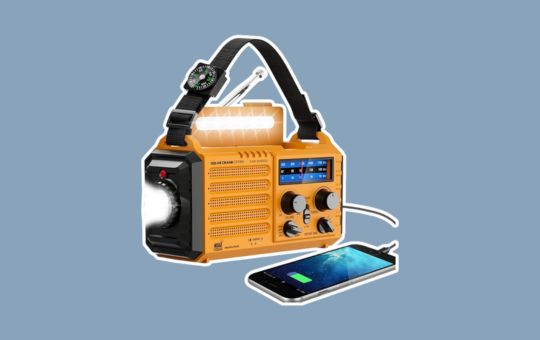
The Eoxsmile Emergency Radio is one of those compact survival tools that tries to cover several bases at once: it’s a radio, flashlight, reading lamp, phone charger, and even an SOS alarm. On paper, it sounds like the Swiss army knife of emergency gear. But if you’ve read through enough buyer reviews (as we did), you’ll notice a pattern: some features shine when you need them, while others are more of a “good to have but don’t lean on it too hard” situation.
The basics: it runs on a rechargeable battery that can be powered three ways: solar, hand-crank, or USB. It covers AM/FM plus NOAA weather alerts, which makes it useful for storms or blackouts. There’s a front-facing flashlight, a softer reading lamp tucked at the side, and the option to sound an SOS siren if you’re stranded. The phone-charging function is probably the feature most people buy it for, though that’s also the one that seems to frustrate users the most.
What stands out? The NOAA weather alert function. According to users, it’s surprisingly reliable at catching warnings, even in more rural areas. Several reviewers compared it with higher-priced radios and found the alerts came through consistently. That’s the part you’d want to trust in an actual emergency.
And the drawback? Charging power. Yes, technically, you can crank it or let it sit in the sun, but the solar panel is small; realistically, it’s more of a backup trickle charge than a daily charging method. And while you can use it to top up a phone, based on reviews, it won’t bring a modern smartphone anywhere near a full charge. Think “enough to get a call out,” not “enough to scroll TikTok for an hour.”
One thing that’s interesting, some buyers mentioned the reading lamp was more useful than they expected. Not bright like an LED lantern, but enough to read a map or cook by candlelight when the power’s out. Little features like that often matter more than the headline specs.
Who’s it for? Honestly, this isn’t the radio for hardcore preppers who want to live off-grid for weeks. It’s more for households that want a compact, reliable backup in case of weather emergencies. Think families in storm-prone areas, or hikers who like to pack light but still want NOAA alerts on the trail.
✅ Pros
- NOAA weather alerts are consistent and dependable
- Multiple light modes (flashlight + reading lamp) add real versatility
- Compact and lightweight, easy to keep in a drawer or emergency kit
- Multiple power sources: solar, crank, USB
- SOS alarm feature for emergencies
⚠️Cons
- Solar panel is very slow, more of a backup than a primary charger
- Phone charging is limited, won’t fully charge modern smartphones
- Build quality feels plasticky to some users
- Crank charging requires effort for only a little power
- Siren volume isn’t as loud as some expected
Earthava’s take: So, while the marketing makes it sound like a miracle gadget, the real-world performance is more modest. Our research shows it’s dependable for weather alerts and basic lighting, but it shouldn’t be your only lifeline if you’re planning serious off-grid use. For households that just want reassurance during outages? It does the job.
Specs And Key Features
| Price: | $35.99 |
| Battery: | 5000 mAh Rechargeable Battery. |
| Voltage: | 5V. |
| Material: | ABS. |
| Color: | Black & Orange. |
| Weight: | 14.9 Ounces. |
| Dimensions: | 6.77 x 3.7 x 2.91 Inches. |
| Lumens: | 150/300. |
| Bulb Type: | LED. |
| Key Feature: | MultiPurpose. |
8. SJPRO: 3000 Lumens Solar LED Flashlight
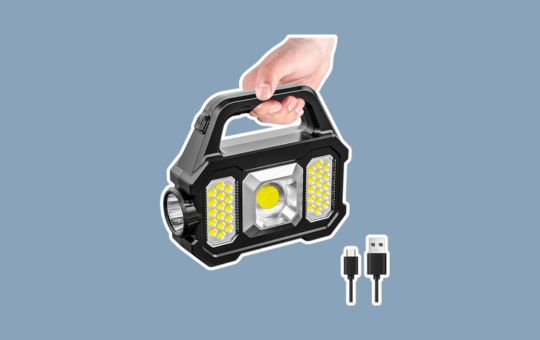
The SJPRO Solar Handheld Flashlight is pitched as a lightweight, waterproof, multi-mode searchlight that can double up as an emergency tool. On paper, it looks like one of those “everything in one” outdoor flashlights you keep in a drawer and hope you never need… until you actually do.
Now, the standout feature? Brightness for the weight. According to several users, the beam is surprisingly strong given how light the unit feels in hand. It’s not military-grade, but if you’re setting up camp or looking for a lost tent peg in tall grass, it does the job well.
The drawback, and this keeps coming up, is the solar charging speed. In our research, many reviewers found that leaving it in direct sun for a full day still doesn’t bring the battery anywhere near 100%. That’s fine if you’re using solar as backup, but not so great if you were counting on it as your main power source during a long trip. The USB recharge is much more reliable.
Who is this really for? From what we’ve seen, it’s a good fit for casual campers, anglers, or households wanting an emergency backup flashlight. If you’re planning serious expeditions or need something for search-and-rescue type situations, you’ll probably want something more rugged and with a larger battery capacity.
One small aside: a few buyers mentioned the build feels a bit “plasticky.” Not flimsy, but not premium either. That may not matter for the price point, it’s positioned as affordable, but it’s something to keep in mind.
✅ Pros
- Lightweight and easy to carry for long stretches.
- Bright beam for its size.
- Multiple light modes add flexibility.
- Waterproof enough for outdoor rain conditions.
- Dual charging (USB + solar) for emergencies.
⚠️Cons
- Solar charging is slow and unreliable as a primary power source.
- Plastic build may not inspire confidence for heavy-duty use.
- Beam distance is shorter than marketing suggests.
Earthava’s take: the SJPRO solar flashlight earns its spot on this list because it balances brightness, portability, and emergency features at a budget-friendly level. It’s not flawless, the solar panel works more like a trickle charger than a true power solution, and the materials feel entry-level, but for most casual outdoor uses, it seems to do what it promises without too many surprises.
Specs And Key Features
| Price: | $39.99 |
| Battery: | 1200 mAh Battery. |
| Color: | Dark Blue. |
| Material: | ABS. |
| Light Color: | White. |
| Weight: | 9.9 Ounces. |
| Lumens: | 1000. |
| Bulb Type: | LED. |
| Warranty: | One Year. |
8. ThorFire: IPX6 Waterproof LED hand-crank Solar Flashlight
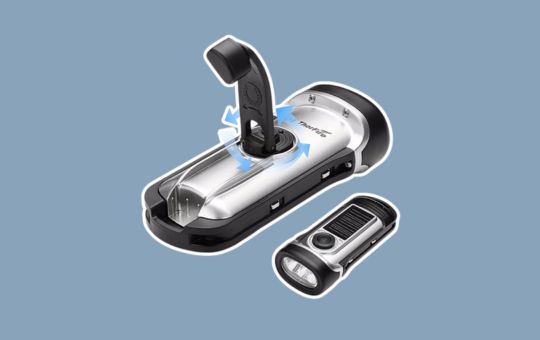
The ThorFire Solar Flashlight Hand Crank has been floating around outdoor forums for years now, mostly praised as one of those “just in case” tools that quietly earn a permanent spot in the glove box or the corner of a camping pack. It’s not a powerhouse, but what it does offer is resilience. Based on reviews and specs, it’s built with a mix of solar charging and a manual hand crank, the kind of redundancy that makes sense when you’re far from an outlet and can’t afford a dead light.
Specs-wise, you’re looking at IPX6 waterproofing, meaning it can shrug off rain and splashes but won’t survive being dropped in a lake. It’s compact and lightweight (about the size of a small TV remote), uses 3 LEDs for illumination, and has dual charging: sunlight or hand crank. One minute of cranking reportedly gives you about an hour of dim light, though in reality, according to users, it’s closer to 30–40 minutes of usable glow. Still, that’s not bad for something powered by your wrist.
The standout feature here is durability. Owners repeatedly mention tossing it around, leaving it in the car during heat waves, or dropping it on rocky trails, and it keeps working. It feels more like a backup tool than a primary light source, but it’s a dependable backup. The big drawback, however, is brightness. Many reviews note that while it’s fine for reading a map or moving around a tent, it’s not nearly as bright as modern LED flashlights. Think “enough to get by” rather than “turning night into day.”
Who’s this really for? In our research, it’s best suited to minimalists, backpackers, or emergency preppers, people who value having a failsafe light source, even if it’s not the most powerful. It’s also a favorite for glove compartments, bug-out bags, and “what if” kits. If you’re planning a serious night hike or need a spotlight for fishing, this isn’t your tool. But if you just want a flashlight that never truly dies, the ThorFire makes sense.
A quick note: some users complain about the solar charging being slow (and it is). Left in direct sun for a full day, it charges enough for short bursts of light, not hours of runtime. The crank is the real hero here, not the solar panel. That’s a point worth remembering because product listings often oversell the solar side.
✅ Pros
- Dual charging: solar and hand crank for true off-grid use
- Compact, lightweight, and tough enough for rough handling
- IPX6 waterproof, suitable for rain and camping conditions
- Very affordable compared to other survival flashlights
- Reliable as a backup, it just keeps working
⚠️Cons
- Light output is relatively weak (not a primary flashlight)
- Solar charging is slow and limited
- The hand crank provides less runtime than advertised
- Not ideal for people who need strong, long-distance beams
Earthava’s take: the ThorFire isn’t the kind of flashlight that makes you say “wow.” It’s the kind that quietly sits in your pack for months, and when you actually need it, you’re glad you threw it in. Underwhelming brightness, yes, but a surprisingly loyal survival tool.
Specs And Key Features
| Price: | $25.99 |
| Color: | Silver & Black. |
| Bulb Type: | LED. |
| Weight: | 0.39 Pounds. |
| WaterProof: | IPX6. |
| Key Feature: | Handy. |
10. Simpeak: Hand Crank Solar Flashlight
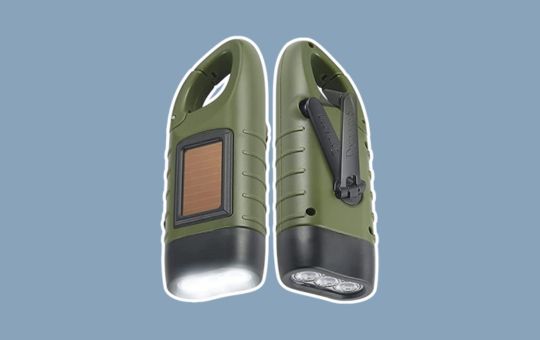
If you’ve ever fumbled for light during a blackout or halfway up a trail when your phone’s flashlight dies, you’ll get why compact solar torches like the Simpeak set exist. This particular bundle, two small hand-crank solar flashlights with built-in carabiners, is best known for being inexpensive and practical in emergencies, not for blowing anyone away with brightness.
Let’s be real here: these are survival lights. According to users, the LEDs are modest (about 8 lumens, though Simpeak doesn’t officially list the number), which means they’re not meant for lighting up a campsite but rather for basic tasks: finding the keyhole, checking a map, or navigating a tent at night. In our research, people repeatedly mention that the quick-snap carabiner design is surprisingly handy; you can hook it to a backpack strap and forget about it until you need it.
Now, the standout feature here? Definitely the dual-pack format. Having two means you can stash one in your car emergency kit and keep the other in your hiking bag, or hand one to a friend who forgot theirs. That’s a subtle but real strength in the budget survival gear category.
The drawback? Brightness and runtime. Based on reviews, one minute of hand cranking gives you roughly 8 minutes of dim light, fine for short bursts, but not something you’d rely on for hours. The solar panel helps, though it’s slow. Left in full sun, users report it’ll take a whole day to give you a small charge. That’s expected at this price point, but worth calling out because the marketing can sometimes oversell the “solar power” angle.
Who’s it really for? Our research shows it appeals most to casual hikers, families building basic emergency kits, and anyone who likes to keep a “just in case” tool hooked to a backpack zipper. This won’t cut it if you’re preparing for long off-grid treks or want a flashlight to double as your main camping light.
✅ Pros
- Two-pack value, one for the car, one for the outdoors
- Dual charging: solar + hand crank
- Compact, lightweight, and easy to carry
- Carabiner clip for quick attachment
- Affordable price point
⚠️Cons
- Light is dim (around 8 lumens, based on reviews)
- Solar charging is very slow
- Short runtime per crank
- Not fully weatherproof
- Works better as a backup than a main flashlight
Earthava’s take: these Simpeak flashlights are like the spare tire in your trunk: not something you’ll rave about, but when you suddenly need it, you’ll be glad it’s there. They won’t light up the forest, but they’ll keep you steady in a pinch.
Specs And Key Features
| Price: | $16.89 |
| Voltage: | 3V. |
| Bulb Type: | LED. |
| Material: | ABS. |
| Color: | Green. |
| Dimensions: | 2.36 x 1.97 x 5.91 inches. |
| Weight: | 3.03 Ounces. |
Why You Can Trust Our List
We haven’t personally tested each flashlight, but we built this selection using verified buyer feedback, expert ratings, and reliable product specs to guide you toward thoughtful, well-performing options.
FAQ
How Do Solar FlashLights Work?
Solar flashlights work using the same principles as solar panels on your home’s roof. The main difference is that instead of turning sunlight into electricity, they turn it into light.
Solar panels absorb photons of light and convert them into electrons (the particles that make up atoms). These electrons flow through wires to create an electric current, which flows through a circuit to power whatever device you’ve plugged in (iPhones, laptops, etc.).
Solar flashlights take advantage of this process by placing two different types of material together: one that absorbs photons from the sun and another that creates electricity when hit with electrons from the first material. This creates an electric current that can be used to power an LED bulb or other components inside your flashlight.
How Much Do Solar FlashLights Cost?
Solar flashlights can range in price from $10 to $50 depending on the model and brand. The most expensive ones tend to be larger, brighter, and more waterproof than other models. If you’re looking for something small and lightweight, you might find yourself spending less than $20. If you want something bright enough for emergencies or camping trips, expect to spend between $25-$30 on average for an inexpensive model.
You can find some solar-powered lights that are much cheaper than this — but these may not be as durable or waterproof as others that cost more money. As with most things in life, you get what you pay for when it comes to solar-powered flashlights!
What Are The Advantages Of Solar-Powered FlashLights?
Solar-powered flashlights are a great alternative to traditional flashlights. They are easy to use and will provide you with light whenever you need it. The following are some of the advantages of solar-powered flashlights:
Environmentally Friendly – Solar-powered flashlights do not use any batteries or electrical sources. This makes them environmentally friendly, as they do not contribute to pollution and waste in any way. In addition, they will not add to landfills when no longer in use.
Powerful Light – Solar-powered flashlights provide a powerful light that is bright enough to see in most situations. The amount of light provided depends on the size of the flashlight and whether it is water-resistant or waterproof. Some smaller flashlights provide enough light for reading at night, while others can be used for camping or hiking at night without worry about running out of battery power or needing an outlet for charging your device.
Portable – A solar-powered flashlight is very portable because it can easily be carried around wherever you go without adding any weight to your luggage or purse. Most models also come with a lanyard so you can hang them around your neck when walking at night or camping outdoors during the day so that they are always close by.
What Are The Disadvantages Of Solar FlashLights?
The disadvantages of solar-powered flashlights are the same as the advantages.
They don’t need batteries and they’re not dependent on electrical outlets or charging stations, but they also have a limited amount of power and are less practical for long-term use.
Flashlights that rely on batteries have more power than solar-powered flashlights. They can last for days or weeks without needing to be recharged and some models have enough juice to keep running even when the flashlight is turned off. Solar-powered flashlights don’t have that kind of battery life because they rely on sunlight instead of electricity. This means they can only store so much energy at one time before they need to be charged again.
Another disadvantage is that these flashlights often come with small batteries that are only good for a few hours at best, which isn’t much help if you’re stuck outside at night with no shelter nearby (or during an emergency power outage).
How To Take Care of Your Solar LED FlashLights?
It’s very easy to take care of these solar flashlights because they have no wires or batteries that need regular replacement. You just have to make sure they’re charged up daily and they’ll work fine for you.
If you want to extend their life even more, here are some tips:
Keep them out of extreme temperatures – when it’s cold outside, keep your device in an insulated pocket or bag so it doesn’t freeze up. When it’s hot outside, try not to leave them in direct sunlight for too long because they can overheat easily, especially if there is no cloud cover above them during the daytime hours.
Don’t drop them – even though these devices are made from durable materials such as plastic or aluminum alloy, dropping them onto hard surfaces can cause damage over time such as cracks or dents in the housing or lens covers; so always keep them protected when not in use.
Conclusion
We have picked the best solar flashlights you can buy right now. We have answered the most critical questions and highlighted the practical aspects of each product to help you make a decision. Whether you prefer lights with a crank or a solar panel or the ready alternative of batteries, there is something for everyone here.


